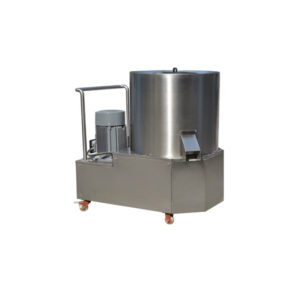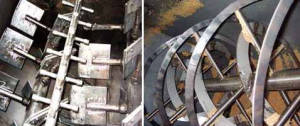The importance of the mixer

Reason 1:
In recent years, there have been significant advances in mixer machines. These improvements are specifically for the food extrusion production line. These advancements have greatly contributed to the success of modern food production. They have also helped develop new products. Additionally, they have increased production consistency and lowered production costs. This article discusses mixer machines used in food extrusion. It also covers the latest mixing technologies available to food producers today. Keep reading to learn how these mixer devices work. You will also discover how they differ from traditional mixers.
Reason 2:
Before exploring the features of mixing machines, it’s important to understand the different mixing styles used in the food extrusion industry. Their uses and applications are often determined by the state being mixed. Blending phases can be solid- solid, liquid- solid or liquid- liquid phases. Modern mixing technologies often overlap in their uses and functions. As a result, some applications can be produced using two or more mixing styles. In such circumstances, it is important to select the best mixing technology to ensure process optimization.
What is a mixer machine for the food extrusion line?
The powder or flour mixer machine is an expressly designed tool for food extruders. These appliances can either be vertical or horizontal processes which are ideal for mixing various types of ingredients.

Vertical mixers
Vertical mixers are designed with two upright screws. These screws lift raw materials to the top of the mixer. The materials then fall back down to the base due to gravity. From there, they are either channeled to the extruder or lifted up again.
The vertical mixing machine is suitable for blending small quantities of fluids, lipids and other raw materials with varying proportions.
Horizontal mixing machines
Unlike the vertical mixers, the horizontal mixers have a set of blades which are mounted on a horizontal rotor. The horizontal rotor has knives fitted onto it. These knives transport ingredients from one part of the machine to another. As the ingredients are moved, they are spun and mixed. The rotors run very fast breaking particles into small droplets and eject the ingredients into the surrounding mix, hence making a hydraulic shear. As more ingredients are expelled from the machine, more batches enter the rotator, promoting a continuous flow of ingredients into the machine. Like the vertical machines, these horizontal machines drop their ingredients from the bottom of the containers, although some may release ingredients from the top.
Mixing moist ingredients
The machine is appropriate for mixing wet raw materials, although they are hard to clear as the horizontal rotors can retain portions of the ingredients. Sticky ingredients like pasta and sugars may stick on the blades. This type of appliance is also suitable for preparing beverage solutions, pastes, sauces, dressings, syrups, dispersions and other suspensions.
Additionally, this classy machine can also be used to blend dry materials. The mixing machine can be available in varying production capacities from smaller dimensions ideal for mixer smaller rations to larger devices suitable for mixing bigger rations. In most cases, larger machines drop their products from the bottom.
Why are mixer machines necessary in food extrusion?
Mixer machines are increasingly becoming popular in food extrusion industries, thanks to their endless benefits they offer manufacturers and consumers.
Benefits for manufacturers:
1. Automation.
The operation of the device is simple and less problematic, unlike the conventional machines which are manually operated. This is because the machine is custom-made with appropriate parameters such as temperature and pressure, so handling is reduced.
2.Easy cleaning.
Modern mixing machines are designed with in-built self-cleaning modifications which reduce the possibility of contamination of the mixed ingredients. In addition to this the feature also reduces labor related expenses.
3.Versatility.
A variety of raw materials and ingredients can be mixed using one mixing line. This is also made possible when using the horizontal mixing machine which is appropriate for blending moist and dry ingredients of varying dimensions. This means that the device can be helpful for anyone manufacturing food using a food extruder.
Examples of foods which can be processed using the mixing machines include candies, pet foods, gels as well as other viscous formulations.
4.Production of high-quality products.
The mixing machine blends the ingredients thoroughly, ensuring uniformity in blending and texture of the final product. In addition to that, the machine is interlinked to the food extruder, so the end product is released into the extruder, reducing handling and contamination. Unlike other traditional methods, this machine also protects the nutritional integrity of the product since ingredients are competently weighed by the machine.
5.Convenient for large scale manufacturers.
When it comes to mixing ingredients in large quantities like in big manufacturing firms, using the mixing machine is convenient and profitable. For instance, it reduces losses from spillages while ensuring faster production at the same time.
6.Efficiency.
The mixing device is efficient in that it ensures the ingredients are thoroughly mixed, taking less time, unlike conventional mixing machines.
Limitations
While this mixing device helps to eliminate serious issues such as spillages, manual operation, labor costs and other extensive issues, it also presents some serious limitations. For instance, self-cleaning may not be very efficient, requiring regular servicing with skilled personnel to handle the device successfully. In addition to this, clogging is also common. As the feed rate and viscosity of the products increases, the efficiency of the rotor and the knives in the machine may be affected, particularly in the vertical mixer. Balancing the performance of the rotor can also be difficult at times,
The above evolutionary advancements in the food mixing technologies give a great opportunity for food manufacturers to revise their product uniformity, improve efficiencies, enhance their production flexibility and strengthen the overall production effects.
However, before deciding to invest in a particular production system, it is important to take on a rigorous testing plan with a trustworthy and skilled equipment developer. It is also imperative to confirm the mixing strategy by undertaking a trial on various potential candidates while using the available raw materials and operating parameters. Investing in these modern technologies will go a long way in enhancing the efficiency of production.


